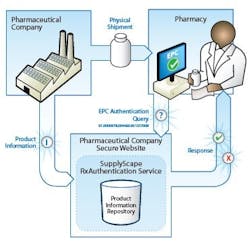By Paul Thomas, Managing EditorAs promised for 2006, Pfizer has begun shipping each and every bottle of Viagra with an RFID tag embedded in its label. The company is using Tagsys 13.56 MHz (high frequency or HF) tags at the item level, as well as Alien 915 MHz (ultra high frequency or UHF) squiggle tags at the case and pallet level, and incorporating software from Systech and SupplyScape to manage and track data throughout the supply chain.Pfizer has spent some $5 million dollars on the development of its RFID pilot for Viagra. As an extension of the program, the company recently initiated, utilizing SupplyScapes e-pedigree software, a new service that will allow supply chain partners to verify electronic product codes via the Internet. After reading a bottles electronic product code (EPC), found on both the RFID tag and a 2-D barcode, a warehouse worker or pharmacist can plug that information into a secure web site and guarantee that the bottle is the same as that shipped by Pfizer."This is all about patient safety, says Peggy Staver, director of trade product integrity at Pfizer. We are providing wholesalers and pharmacies a way to quickly and efficiently confirm that the EPC serial number on Viagra is authentic."To get the inside story on the present and future of the Viagra RFID program and the authentication service, Pharmaceutical Manufacturing recently spoke with Staver. Following the interview, read the press release announcing the details of the web-based authentication program.P.M.: Whats the status of the web-based authentication program for Viagra? Whats the level of participation?P.S.: It is up and running as of January 1, and available for anyone with an account. Of course, many in the supply chain dont have the hardware the RFID readers and scanners to read the tags, so participation is pretty limited now.There are two options for authenticating the product. The first is to read the tag with the EPC number encoded on that, but the second option is to read a 2-D bar code printed on the label that has the same number. Still, we dont have as many people involved as we hope to.I know of one wholesaler that has the infrastructure in place to read the tags, and one other that should have the capability in place within a few weeks. And for all of our wholesalers, the customers they ship to are in various stages of putting RFID in place.P.M.: The authentication program will allow warehouse operators and pharmacists to guarantee that the product bottle is the same as that produced in your facility, but how can you guarantee that that bottle and the drugs inside havent been tampered with?P.S.: Were very careful to say that what were doing now is enabling the authenticity of the EPC number. We cant absolutely say the product hasnt been tampered with. Once we have more involvement from our supply chain partners and develop full track and trace capability, then we can marry authentication with physical verification of the product.This is an incremental step. Between tamper-resistant technology and other means, you add barriers. Technology isnt the only solution. Technology alone wont prevent counterfeiting. Youve got to have cooperation with supply chain partners.It also requires a change in business practices, and that includes wholesalers buying directly from distributors and not in the secondary market. Weve modified our terms of sale to say that those who distribute Pfizer products need to buy their products from us or a Pfizer-authorized distributor of record. To the extent that trading partners know that theyre engaging in safe business practices, and that consumers know theyre buying from those that they know and trust, theres an added level of security.But nothing is foolproof that I know of. It requires different business practices, increased oversight and regulation of those who distribute product, increased enforcement, and technology. Its a combination of all of those that will deter counterfeiting.P.M.: Short of paying for the hardware yourself, what are you doing to encourage participation on behalf of your supply chain partners?P.S.: We are working by the domino effect. We decided not just to do this with select customers and select SKUs of Viagra, so that anyone could begin to participate. But because of the cost involved, I know that even those of our supply chain partners planning to invest in RFID are doing so on a limited basis. They might be trying it out in one distribution center and a few stores, for example, so they can gain some experience with the technology.Were not doing anything to mandate implementation. Were putting it out there, hoping that others will see the advantages as well. Since weve made the investment, we believe others will begin to as well. Everybody in the supply chain has different drivers for adopting the technology. For us, its patient safety. For wholesalers, its compliance with pedigree laws and operational efficiency. For pharmacists, its operational efficiency.P.M.: What will you focus on in 2006?P.S.: Well spend 2006 collecting data from those in the supply chain willing to help out, and looking at what the performance utility of technologies in the market is. Once we have some of this information, well begin to assess what other drugs besides Viagra might benefit from a similar program.P.M.: How is Pfizer deciding what aspects of its RFID program to publicize, and what not to?P.S.: At this point, weve been very open and so have others in our industry. Theres so much yet to learn. Were all going through this together and see a benefit in it. This offers an opportunity for us to collaborate at least in terms of general areas on implementation of the technology.Obviously, we wouldnt disclose some of the covert things we do with our packaging or product. But in this case, weve got a tag on our bottle and we tell everybody its there. Theres even a text message on the side of the bottle that says, This package contains a radio frequency device. Were trying to be open with consumers to let them know were not spying on them. Were collecting no patient information. Were just trying to enable the tracking and authentication of the product.The following is SupplyScapes recent press release on the RxAuthentication service:Web-Based Service Provides Safety Net that Confirms Drug Electronic Product CodesSeeking to help protect customers from counterfeit drugs, SupplyScape Corp. announced that it has launched the SupplyScape RxAuthentication Service. For the first time, the serial number of each pharmaceutical package, called an Electronic Product Code (EPC), can be verified as authentic before the drugs are dispensed to U.S. consumers. The RxAuthentication Service leverages Radio Frequency Identification (RFID) tags to store the EPC of the drug package, which pharmacies and wholesalers can verify over the Web (see diagram below).
"Confirming the drugs Electronic Product Code is authentic is a critical step in protecting Americans from counterfeit drugs," says SupplyScape Corp. President and CEO Shabbir Dahod. This authentication service provides a safety net whereby pharmacies and wholesalers have a quick and easy method for ensuring that each pharmaceutical packages EPC did, in fact, originate from the pharmaceutical manufacturer.Pfizer, Inc. announced plans to pilot RFID technology and the authentication service in the U.S. with its Viagra (sildenafil citrate) brand. According to the companys public statements, U.S. wholesalers and pharmacies will be able to read the serial number on the RFID tag of Viagra and confirm that it is, in fact, a valid EPC issued by Pfizer for that drug."At Pfizer, this is all about patient safety, says Peggy Staver, Director of Trade Product Integrity at Pfizer. We are providing wholesalers and pharmacies a way to quickly and efficiently confirm that the EPC serial number on Viagra is authentic."In the future, the same RxAuthentication Service could be used to inform pharmacies about recalled products and provide up-to-date product information.





